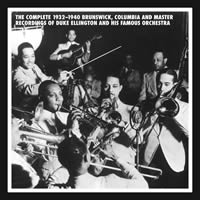Re: Duke redux
|
Art Lange [June 2011.]
Duke ELLINGTON: The Complete 1932-1940 Brunswick, Columbia and Master Recordings of Duke Ellington and His Famous Orchestra. Mosaic MD-11 248 (11 CDs) (http://www.mosaicrecords.com/). A slice of Duke Ellington’s 50-year recording history — especially one as thick, rare, and mouth-watering as this — is a slice of Americana, revealing as much about the practices of the music industry, the position of popular music in society, and the racial climate of the period, as it does Ellington’s particular musical genius and the talents of the musicians who interpreted, illuminated, and often inspired his compositions. By 1932, Ellington had already achieved success as a bandleader at New York’s Cotton Club, which featured an elaborate revue including singers, comedians, specialty dancers, and staged musical skits, and had written and recorded enough hits — among them, “Mood Indigo,” “Black and Tan Fantasy,” “The Mooche,” and “Black Beauty” — to justify his band’s “famous” tag. Even so, his popularity grew enormously over the next eight years, despite the nationwide Depression and his own personal bouts of depression. Shrewdly managed by music industry wheeler-dealer Irving Mills, and as ambitious as he was talented, Ellington quickly learned how to walk the tightrope between entertainment and art in a culture where the former is rewarded and the latter is suspect. This meant that his orchestra, of necessity, had to be a show band, a dance band, a band of versatile accompanists, and still function with the creative edge that identified it as a jazz band. Moreso than any other significant jazz composer, Ellington conceived and arranged his music with the specific tonal qualities and, just as importantly, the personalities of his band-members in mind, in a manner both psychological and alchemistic. (He once commented that “You can’t write music for a man if you haven’t played poker with him.”) As the Cotton Club revue frequently included racy, exotic, African-tinged musical skits, Ellington devised a “jungle sound” by combining the growling muted trumpet of James “Bubber” Miley, trombonist Joe “Tricky Sam” Nanton’s plunger effects, and the seductive lilt of Barney Bigard’s clarinet. When Miley died in early 1932, he was replaced by Charles “Cootie” Williams, who took the growl trumpet role to even greater heights of expression. Williams and Bigard are the instrumental stars of this collection; witness the fact that Ellington inaugurated his series of featured “concertos” for members of the orchestra with “Echoes of Harlem” and “Clarinet Lament,” both composed in 1936, respectively. Bigard could supply an effectively ornamented line for anything ranging from a sophisticated blues like “Saddest Tale” to a flashy romp like “Lightnin’” with its hints of polytonality. But Williams’ growl added an audacious exhilaration to otherwise non-threatening pieces like “Moon Over Dixie” or “Stormy Weather” — something akin to the garish colors in a German Expressionist portrait, or a roughneck at a society function. Ellington’s rich scoring often emphasized the different characterizations of instrumental tones; in “Stormy Weather,” Arthur Whetsel’s muted trumpet offers the melody straight in a singing, female tone, followed by Williams’ gruff masculine growling. Of the more than 150 songs presented here (many in multiple takes), approximately one-third were not composed by Ellington, but benefitted from an Ellingtonian coloristic detail or invigorating solo. Many of these were assigned by Irving Mills, especially the popular tunes with insulting lyrics like “Delta Bound,” “Cotton,” and “Shoe Shine Boy,” remnants of minstrel show stereotypes performed in a nonetheless professional manner. Apparently Ellington drew the line at “In the Shade of the Old Apple Tree,” however, which he amusingly destroyed with Guy Lombardo-styled phrasing, tongue-in-cheek quotations in the solos, and dissonant notes sprinkled throughout. More than a few Ellington classics are here, of course: “It Don’t Mean a Thing (If It Ain’t Got That Swing),” “Solitude,” “Creole Love Call,” “Sophisticated Lady,” “Drop Me Off in Harlem,” the original versions of “Diminuendo in Blue” and “Crescendo in Blue,” “I Let a Song Go Out of My Heart,” “Prelude to a Kiss.” But there’s a deeper pleasure in the discoveries to be made, in neglected yet charming pieces like “Oh Babe! Maybe Someday,” the suave “Riding On a Blue Note,” the exotic “Battle of Swing,” and romantic “Old King Dooji;” in the consistently fascinating solo work; and in the rhythmic evolution of the orchestra, from its early clip-clop dance style to a streamlined, variously articulated swing. Something changed around 1939. Some commentators believe Ellington escaped from a personal funk, others say it was that he escaped from the grasp of Irving Mills, still others suggest it was the influence of new friend and collaborator Billy Strayhorn. Whatever the case, he initiated an amazing string of elegant, eloquent, emphatic new compositions that was to stretch into the next decade and beyond. In 1940, what was to become known unofficially as “the Blanton-Webster band” because of the infusion of several new members, including bassist Jimmy Blanton and tenor saxophonist Ben Webster, began recording for RCA Victor. Ellington’s fame was, by now, international, and he had just reached his prime.
[More Art Lange]
[More
Ellington]
[Previous Article:
Passion, Passion]
[Next Article:
200 Ans de Musique à Versailles]
|
